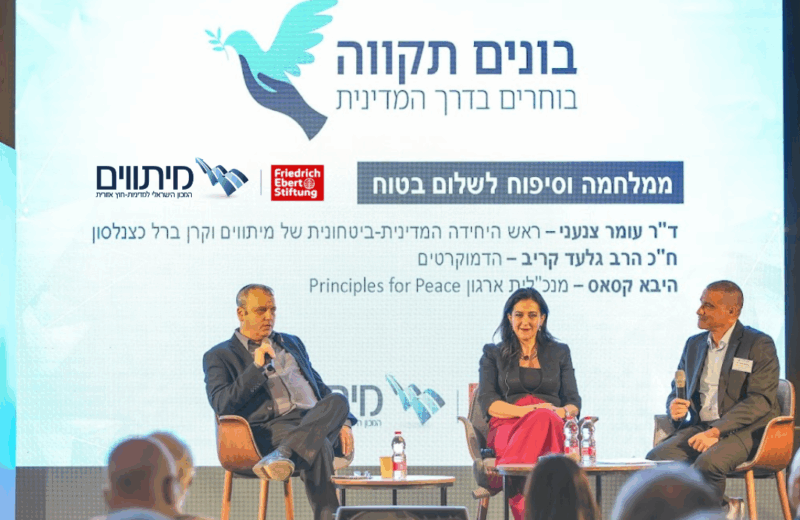 / All Events
/ All Events
“The Israeli public understands the failure of ‘conflict management.’ There is a public – but it has no leadership that speaks to it clearly.”
With this sharp statement, MK Gilad Kariv described one of the core problems raised in the political-security panel held at Mitvim’s 8th Annual Conference, in November 2025 at the Yitzhak Rabin Center in Tel Aviv, in partnership with Friedrich Ebert Stiftung Israel.
The panel brought together researchers, diplomats, policymakers and regional leaders for an in-depth discussion on the regional landscape and the day after the war.
The panel, titled “From War and Annexation to Secure Peace”, was moderated by Dr. Omer Zanany and featured two main speakers: Hiba Qasas, CEO of Principles for Peace and leader of the Uniting for Shared Future coalition, and MK Gilad Kariv. Together, they presented a multi-layered regional assessment and a renewed framework for thinking about the future of the political process and the roles of Israel, the Palestinian Authority, and the region.
“A historic moment – full of opportunity and full of danger”
Qasas opened with an analysis of the regional environment, emphasizing that we are living through a rare moment, shaped by simultaneous developments: heightened international involvement, new regional willingness for cooperation, and the emergence of an initial political blueprint for the day after in Gaza.
For the first time in years, she noted, regional states – especially in the Gulf – are prepared to assume an active and responsible role not only in funding and reconstruction, but also in governance, oversight and stabilization mechanisms.
Qasas highlighted a broad international consensus that Hamas cannot be part of Gaza’s future governance, and that the Palestinian Authority must – and has already begun to – undertake significant reforms. She stressed that Israel’s focus on the debate over “recognition of a Palestinian state” missed the true meaning of the current international moves: the creation of an enforceable framework for reconstruction, demilitarization, and a long-term political process.
She also pointed to a major obstacle to progress: Israel’s opposition to the PA’s involvement in Gaza.
“Arab states will not agree to become a replacement occupying force,” she said.
“The PA is the only actor willing to cooperate with Israel and the international community – and it must be involved from day one.”
Qasas described deep shifts in Palestinian public opinion: a dramatic rise in support for the two-state solution, alongside a sharp drop in support for Hamas, despite the dire humanitarian situation.
At the same time, she reported on internal PA reforms: a draft constitution grounded in liberal values and human rights, changes in budgetary and education policy, and a genuine desire – especially among younger Palestinians – for a renewed leadership working toward self-determination while recognizing Israelis’ right to security and statehood.
“Against this opportunity stands a crisis of Israeli leadership”
Kariv opened his remarks with a stark warning: “The situation in the West Bank is on the verge of explosion.”
He pointed to escalating settler violence and expanded de-facto annexation – measures he described as “a deliberate attempt to sabotage any hope for a political process.”
At the same time, he noted a paradox: at a moment when both the region and the international community are mobilizing to advance a political vision, Israeli society is left without leadership willing to discuss it openly.
According to Kariv, for three decades Prime Minister Benjamin Netanyahu successfully blurred the line between responsible policy and “radicalism,” making any criticism of government policy taboo within the political right and even parts of the center.
The result, he argued, is a deep paralysis within Israel’s liberal camp, which fears voicing positions that actually reflect the views of a majority of the Israeli public.
“Many studies – including by politically unaffiliated bodies – show that the Israeli public has not dramatically shifted rightward,” he said. “It understands the failure of conflict management and the need for an integrated regional-political process.”
Kariv called on the liberal-democratic public to redefine its expectations of its leaders:
“Anyone unwilling to address political-security issues seriously cannot ask for the public’s trust.”
Connecting the bilateral and regional tracks
Kariv outlined a broad strategic view: Israel must reconnect two parallel paths – the bilateral track with the Palestinians, and the emerging regional track led by Arab states.
Israel must avoid returning to the Oslo model, which relied exclusively on a bilateral framework – but also cannot return to the illusion of “regional peace without the Palestinians” promoted under Netanyahu and the Abraham Accords.
The correct approach, he argued, is a hybrid model:
a clear and public affirmation of the two-state solution as the final status goal, combined with detailed, impactful interim steps in Gaza and the West Bank that change realities on the ground rather than remaining rhetorical.
Kariv also stressed the central role of Jordan and Egypt, calling to restore them to the heart of any future framework.
“You cannot build a stable process without Cairo and Amman,” he said. “They are foundational pillars of regional security.”
Between violence and a possible bridge
Kariv concluded with an image drawn from Jewish tradition: Isaac and Ishmael coming together to bury their father Abraham in the Cave of Machpelah. This image, he argued, symbolizes partnership and mutual respect – a direct alternative to the vision of supremacy and violence growing on the ground today.
The panel converged around one conclusion: today’s reality – complex as it is – may yet transform from a breaking point into a turning point.
Israel, the Palestinians, and the region must choose whether to continue spiraling into confrontation or leverage the international and regional momentum to shape a political process that is stable, practical, and fair.
In Qasas’ words:
“We can continue along a path of intergenerational trauma – or choose something entirely different.”
For now, the choice remains open.
Photo & video: Constantin Grossman


